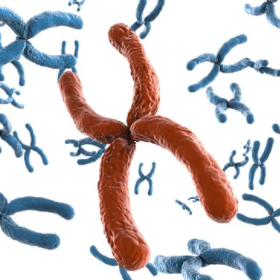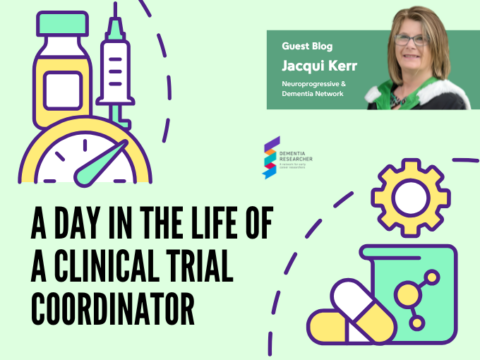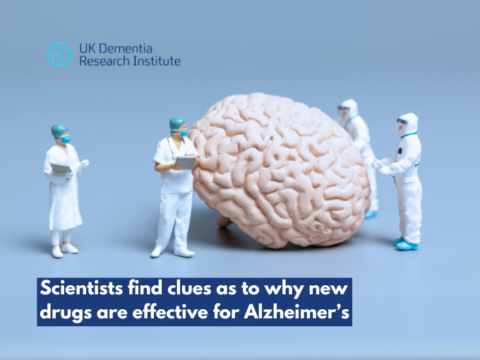Down syndrome is caused by having a third copy of chromosome 21, and each year on the 21st of March (the 21st day of the third month) World Down syndrome Day is celebrated worldwide. People with Down syndrome are particularly susceptible to COVID-19, so this year the Down syndrome research community came together online. With participants from research studies, their families and friends, we discussed current research advances, offered advice from specialists and celebrated Down syndrome. Down syndrome is the most common genetic cause of Alzheimer’s disease, however, few researchers study dementia in this context. Here, I want to highlight my research in this field and explain the importance of the inclusion of people with Down syndrome in Alzheimer’s research.
But why do people with Down syndrome develop Alzheimer’s disease? The gene APP, or amyloid precursor protein, is located on chromosome 21, and so people with Down syndrome inherit three-copies of this gene. When APP is cleaved in the brain, amyloid-beta accumulation occurs, a key hallmark of Alzheimer’s disease pathology. In the case of Down syndrome, this gene is termed “dosage-sensitive”, meaning that an extra copy of the gene results in extra protein production. This causes an increased downstream accumulation of amyloid-beta, initiating the cascade of events that ultimately cause dementia. Not only does this mean that virtually all people with Down syndrome develop Alzheimer’s disease, but this occurs decades earlier than in people without Down syndrome. In fact, the earliest signs of intracellular amyloid-beta accumulation have been seen in foetuses and young children with Down syndrome. Further evidence for the causal role of APP in Down syndrome dementia is seen in rare familial mutations, whereby three-copies of APP alone are inherited, resulting in Alzheimer’s disease. Additionally, partial trisomy of chromosome 21, without APP in three-copies, results in Down syndrome phenotypes, but not Alzheimer’s disease.

Chromosome 21 is one of the 23 pairs of chromosomes in humans. Chromosome 21 is both the smallest human autosome and chromosome, with 48 million base pairs representing about 1.5 percent of the total DNA in cells.
Although having three-copies of APP is sufficient and necessary to cause Alzheimer’s disease in people with Down syndrome, chromosome 21 has over 200 genes, and so people with Down syndrome have three-copies of each of these genes. This leads to a wide array of conditions across multiple body systems, including the immune, cardiovascular, endocrine and nervous systems. A lot of preclinical Down syndrome research focuses on trying to identify candidate genes, that when in three-copies, can cause these phenotypes. To achieve this, mouse models are often used, which have three copies of some chromosome 21 orthologous genes. Using such models, our lab has shown that there are genes on chromosome 21, other than APP, that can modify amyloid-beta deposition and other aspects of Alzheimer’s disease pathology. However, pin-pointing the exact causal genes has been difficult to research due to the genetic complexity of these models. One method to combat this is to generate mouse models which have three-copies of chromosome 21 orthologues, but only two-copies of a candidate gene of interest. This, and other similar strategies, have implicated DYRK1A (a kinase enzyme), USP25 (a deubiquitinating enzyme), as well as APP, in contributing to Alzheimer’s disease pathogenesis in Down syndrome. Other candidate genes are also currently being considered by our lab, particularly those which may play a role in neuroinflammation.
Neuroinflammation is now understood to contribute hugely to Alzheimer’s disease progression. Recent evidence has shown that neuroinflammation occurs in the brains of people with Down syndrome. These studies looked at post-mortem brain tissue from people with Down syndrome, from childhood to old age. Changes to microglia, the primary immune cell of the brain, were observed, including altered morphology, increased levels of proinflammatory cytokines and an altered transcriptomic profile, compared to age-matched individuals without Down syndrome. Why and how this neuroinflammation is occurring is unclear, but as with most Down syndrome phenotypes, it is likely that having three-copies of chromosome 21 genes is central to this. Neuroinflammation is evident in a mouse model of Down syndrome, which has three-copies of many chromosome 21 orthologous genes, indicating that one or more of these genes are causing the phenotype. My work, as well as other projects in our lab, are focused on understanding the cellular and molecular mechanisms of these neuroinflammatory phenotypes, with an emphasis on raised proinflammatory markers and microgliosis. Not only this, but we are working to determine which genes on chromosome 21, when in three-copies, are causal to drive these changes. Defects to the peripheral immune system are very prevalent in Down syndrome, including increased susceptibility to infection and the development of chronic inflammatory conditions. We would like our work to disentangle the role of peripheral versus central changes in driving the neuroinflammation. By understanding these baseline differences, we will be able to better understand how this neuroinflammation further changes upon the onset of Alzheimer’s disease pathology.
Now in the UK, Alzheimer’s disease is the leading cause of death of people with Down syndrome, which is devastating for these individuals and their families alike. Despite the fact that people with Down syndrome have this huge genetic risk for the development of Alzheimer’s disease, they are currently excluded from Alzheimer’s-primary prevention clinical trials. About 1 in 1000 babies are born with Down syndrome in the UK, making Down syndrome a greater risk for Alzheimer’s disease than all autosomal dominant early-onset cases combined. More and more data are emerging on Alzheimer’s disease biomarkers, progression and diagnosis in people with Down syndrome. Hopefully this evidence, as well as those advocating for inclusion, can lead to the consideration of people with Down syndrome for both Alzheimer’s disease clinical trials and potential therapeutic targets very soon!

Clíona Farrell
Author
Clíona Farrell is a PhD Student in the UK Dementia Research Institute at University College London. Her work focuses on understanding neuroinflammation in Down syndrome, both prior to, and in response to, Alzheimer’s disease pathology. Originally from Dublin, Ireland, Clíona completed her undergraduate degree in Neuroscience in Trinity College, and then worked as a research assistant in the Royal College of Surgeons studying ALS and Parkinson’s disease. She also knows the secret behind scopping the perfect 99 ice-cream cone.

 Print This Post
Print This Post




